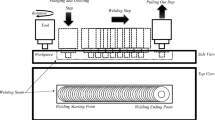Abstract
Friction stir welding (FSW) is the preferred joining method for metal-matrix composites (MMCs). As a solid-state process, it precludes formation of the intermetallic precipitates responsible for degradation of mechanical properties in fusion welds of MMCs. The major barrier to FSW of MMCs is the rapid and severe wear of the welding pin tool, a consequence of prolonged contact between the tool and the harder reinforcements which give the material its enhanced strength. This study evaluates the effectiveness of harder tool materials to combat wear in the FSW of MMCs. The tool materials considered are O1 steel, cemented carbide (WC-Co) of the micrograin and submicrograin varieties, and WC-Co coated with diamond. The challenges which accompany the application of harder tool materials and diamond coatings in FSW are also discussed. This study represents the first use of diamond-coated tools in FSW and the first comparative evaluation of tool materials for this application.





Similar content being viewed by others
Notes
Because aluminum accumulates on the probe surface during welding, inserts must be etched prior to analysis. The insert is immersed in a solution of NaOH and water until all the aluminum is eroded from the surface.
Values for diamond are extrapolated.
References
J.M. Kunze and C.C. Bamptom, Challenges to Developing and Producing MMCs for Space Applications, J. Miner. Met. Mater. Soc., 2001, 53, p 22–25
T. Prater, Solid-State Joining of Metal Matrix Composites: A Survey of Challenges and Potential Solutions, Mater. Manuf. Processes, 2011, 26, p 636–648
D. Storjohann, O.M. Barabash, S.S. Babu, S.A. David et al., Fusion and Friction Stir Welding of Aluminum Metal Matrix Composites, Metall. Mater. Trans. A, 2005, 36A, p 3237–3247
Friction Stir Welding, Space Shuttle Technology Summary, 2001, NASA, http://www.nasa.gov/centers/marshall/pdf/104835main_friction.pdf
T. Prater, “Predictive Process Modeling of Tool Wear in Friction Stir Welding of Metal Matrix Composites,” PhD Dissertation, Vanderbilt University, 2012
R.A. Prado, L.E. Murr, K.F. Soto, and J.C. McClure, Self-Optimization in Tool Wear for Friction-Stir Welding of Al 6061+20% Al2O3 MMC, Mater. Sci. Eng. A, 2003, 349, p 156–165
T. Prater, G.E. Cook, A.M. Strauss, J. Davidson, and M. Howell, Parameterization of Friction Stir Welding of Al 6061/SiC/17.5p for Various Tool Materials, 8th International Conference on Trends in Welding Research, Pine Mountain, GA, 2008
T.J. Prater, A.M. Strauss, G.E. Cook, C. Machemehl, P. Sutton, and C.D. Cox, Statistical Modeling and Prediction of Wear in Friction Stir Welding of a Metal Matrix Composite (Al 350/SiC/20p), J. Manuf. Technol. Res., 2010, 2, p 1–13
T. Prater, C. Cox, B. Gibson, A. Strauss, and G. Cook, Dimensional Analysis and a Potential Classification Algorithm for Tool Wear in Friction Stir Welding of Metal Matrix Composites, Proc. Inst. Mech. Eng. C, 2012, 226, p 2759–2769
K. Weinert and W. Konig, A Consideration of Tool Wear Mechanism when Machining Metal Matrix Composites (MMC), CIRP Ann. Manuf. Technol., 1993, 42, p 95–98
T. Prater, Friction Stir Welding of Metal Matrix Composites: The Joining of Al 6061/SiC/17.5p Using Diamond Coated Tools, VDM-Verlag, 2009
F.J. Liu, J.C. Feng, H. Fujii, and K. Nogi, Wear Characteristics of a WC-Co Tool in Friction Stir Welding of AC4A+30% Vol SiCp Composite, Int. J. Mach. Tools Manuf., 2005, 45, p 1635–1639
R.T. Coelho, S. Yamada, D.K. Aspinwalt, and M.L.H. Wise, The Application of Polycrystalline Diamond (PCD) Tool Materials when Drilling and Reaming Aluminium Based Alloys Including MMC, Int. J. Mach. Tools Manuf., 1995, 35, p 761–774
G.G. Roy, R. Nandan, and T. Debroy, Dimensionless Correlation to Estimate Peak Temperature During Friction Stir Welding, Sci. Technol. Weld. Joining, 2006, 11, p 606–608
M.P. Groover, Fundamentals of Modern Manufacturing: Materials, Processes, and Systems, John Wiley and Sons, New York, 2010
E. Rabinowicz, Friction and Wear of Materials, John Wiley & Sons, New York, 1965
R. Diwan, National Aeronautics and Space Administration, Investigation of Friction Stir Welding of Al Metal Matrix Composite Materials, Huntsville, AL, 2002
X.P. Li and K.H.W. Seah, Tool Wear Acceleration in Relation to Workpiece Reinforcement Percentage in Cutting of Metal Matrix Composites, Wear, 2001, 247, p 161–171
Acknowledgments
This study was funded by a NASA GSRP Fellowship from Marshall Spaceflight Center. Materials were provided by composites manufacturer MC21, Inc. Thanks to Dr. Art Nunes of NASA MSFC, Dr. Jim Davidson and Mick Howell of Vanderbilt University (for expertise and assistance with diamond coatings), and Bob Patchin and John Fellenstein in the Vanderbilt Physics machine shop.
Author information
Authors and Affiliations
Corresponding author
Rights and permissions
About this article
Cite this article
Prater, T., Strauss, A., Cook, G. et al. A Comparative Evaluation of the Wear Resistance of Various Tool Materials in Friction Stir Welding of Metal Matrix Composites. J. of Materi Eng and Perform 22, 1807–1813 (2013). https://doi.org/10.1007/s11665-012-0468-9
Received:
Revised:
Published:
Issue Date:
DOI: https://doi.org/10.1007/s11665-012-0468-9




